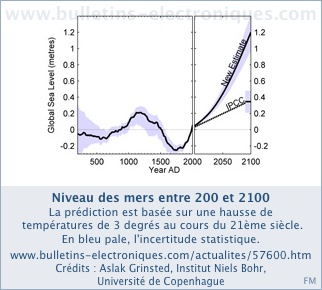| Le niveau des mers pourrait s'élever
d'un mètre dans les 100 prochaines années. C'est trois fois
plus que ce que prédisait le GIEC, le groupe d'experts climatiques
des Nations Unies. Ces résultats spectaculaires ont été
publiés dans la revue "Climate Dynamics" par une équipe
de chercheurs du "Niels Bohr Institute" de l'Université de
Copenhague, en collaboration avec des équipes anglaises et finlandaises.
Les rapports du GIEC prévoient une augmentation globale des températures de 2 à 4 degrés pour le siècle à venir. Mais la température des océans et la fonte des couches de glace qui recouvrent le Groenland et l'Antarctique n'obéissent pas à la même cinématique que le réchauffement atmosphérique. Ce facteur est la grande inconnue de tous les modèles prédictifs du niveau des océans. Or, comme le GIEC l'a lui-même reconnu dans son rapport de 2007, le modèle qu'il utilise pour prévoir l'élévation du niveau de la mer n'est pas capable de prendre en compte les changements rapides que les calottes glaciaires ont connu ces dernières années. Partant de ce constat, l'équipe de recherche a décidé de s'orienter vers de nouvelles stratégies de modélisation. "Alors que tout le monde fait des calculs à partir de ce que l'on estime qu'il pourrait se passer, nous avons décidé de faire les nôtres à partir de ce que l'on sait effectivement du passé. Nous avons ainsi tenté d'établir une corrélation directe entre température mondiale et niveau des océans" explique Aslak Grinsted, géophysicien en charge du projet au Centre de Glaciologie et Climatologie de l'Institut Niels Bohr. Le nouveau modèle est en fait une régression linéaire physiquement réaliste à 4 inconnues qui s'appuie sur les données de ces 2000 dernières années. Les paramètres de l'équation sont estimés par la méthode statistique de Monte Carlo permettant ainsi une représentation des scénarii passés et futurs du niveau des océans. Le modèle offre des capacités prédictives très satisfaisantes sur les décennies passées et anticipe l'accélération observée depuis les années 90.  |
Si l'on estime que la relation température
- niveau des océans est valide de l'an 200 à 2100 au moins
et si l'on se réfère aux différents scénarii
de température du globe avancés par le GIEC, la hausse du
niveau des océans devrait atteindre 0,9 à 1,3m d'ici un siècle.
A titre de comparaison sur la période étudiée, le
niveau le plus bas fut atteint en 1730 avec une baisse de 19 à 26cm
par rapport au niveau actuel, alors que le niveau maximum fut atteint en
1150 avec un niveau de 12 à 21 cm supérieur au niveau actuel.
Ces deux dates correspondent respectivement au petit âge glaciaire
du 18ème siècle et à un pic de températures
observé au 12ème siècle. Le scénario précédemment
soutenu par le GIEC se révèle très improbable selon
le nouveau modèle.
 Pour en savoir plus, contacts:
|